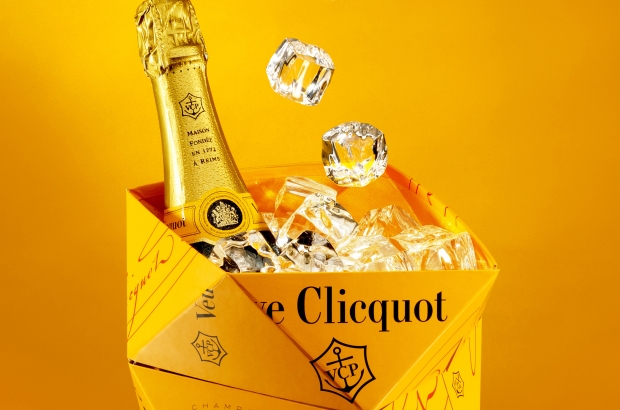- Daily & Weekly newsletters
- Buy & download The Bulletin
- Comment on our articles
With Le Clicq, c’est chic, simplicity and flexibility typify the designer’s work
Even if you haven’t heard Matthias van de Walle’s name, the chances are you’ll recognise at least one of the objects he’s created. Perhaps you even have it lying at home, conveniently folded flat so it fits into your kitchen cupboard. We’re talking about the Clicq’Up: the iconic yellow origami champagne bucket van de Walle designed for French label Veuve Cliquot.
It was one of the young designer’s first projects, and one he remains very proud of. “It looks quite simple, but in reality two years passed between the initial concept, a few dozen prototypes and the final public launch,” van de Walle recalls. “It also took several production tests, so without the ambitious means of the Veuve Clicquot brand, including the production factory input, this project would probably not have been possible.”
In a way, the ice bucket typifies van de Walle’s aesthetic and philosophy. He calls himself a “pursuer of modularity and flexibility” and his work a pursuit of “the object that is practical, easy and economical to produce, store and transport, and design that is meant to be manipulated.” He takes great care to insert the word ‘playful’ in every description, too, and judging from the project that brought him to the public’s attention at Milan Design Week in 2011, this description sounds spot-on.
Van de Walle was born in Brussels but grew up in the countryside of Marche-en-Famenne in the province of Luxembourg. “I’ve always been attracted by all kinds of contraptions,” he explains. “I spent my childhood constructing my own huts, bows and arrows, soapbox carts, and tinkered endlessly in our garage, at my father’s workbench.” When the time came to start his formal education, the young designer moved to Brussels.
He studied interior architecture and design at the College of Architecture and Design, where he could count many internationally recognised designers as his teachers: “I was lucky to have designers like Damien Bhir, Charles Kaisin, Pol Quadens and Fabiann Vanseveren as teachers and follow interior architecture courses with designers such as Patrice Levecq, Jean Loui De Ridder, François Marc and Suzon Ingber.” During his studies in 2005, van de Walle earned the Prix du Jeune Design Belge, which is known today as the MAD Prize.
After his studies, he applied for the Salone Satellite in Milan and was eventually accepted, allowing him to participate in the 2008, 2009 and 2010 editions under the Belgium is Design label, supported by organisations like Wallonie-Bruxelles Design/Mode (WBDM) and the Walloon Export and Foreign Investment Agency (AWEX). It was here that Veuve Clicquot discovered his prototype for the foldable bucket, which two years later took Milan by storm as a finished collaboration between the champagne house and the designer.
Van de Walle has come a long way since then, racking up the collaborations with Danish brand Bolia and Belgian design companies Liparus and Linadura. The latter produces two of his designs: the Crab trinket tray made from plotted aluminium foil shaped into origami folds, and the Face mirror (pictured), which offers a three-faceted reflection. Geometry is a recurrent theme in van de Walle’s work. Liparus currently produces the designer’s Stamp tables: a much more fluid design inspired by the movement of liquids.
Bolia discovered van de Walle’s work in Milan in 2010, when the designer presented a collection of furniture inspired by his grandmother’s manor. “It’s a house with a lot of historical objects and artistic works. I wanted to create objects that will never go out of fashion,” he explains. The result was the L-Chair and La Console, a furniture duo that brings to mind the age-old tradition of boudoirs but reinvents it for the modern age. The designs intrigued the representatives of Bolia.
“I tend to think Belgian design is part of a Nordic movement, due to our geographical position and influence from neighbouring countries. We are all bold purists,” he says. “For the past ten years, we’ve clearly witnessed a revaluation of the Belgian design scene on a national and international scale. I guess this is thanks to numerous local associations that encourage and help creatives start up – WBDM, MAD Brussels, Brussels Design September, Wallonie Design, to name but a few.
“These organisations allow visibility both here and abroad, creating great opportunities for new talents at an early stage. Many new local brands appear thanks to them, allowing Belgian design to be spread abroad.” It explains why he feels comfortable enough in Brussels to spend a few months renovating his home and workshop there. “It’s really quite pleasant to live in Brussels, and you can easily get to anywhere else in Europe from here. You also have quick access to many different materials and qualified workmanship.”
Interview with Matthias van de Walle
Could you describe your aesthetic and philosophy?
I like to deconstruct the stereotypes people have of furniture. I want to create objects that will never go out of fashion, by means of a universal language. Good design, to me, is design without the ‘bling bling’, without artifices, one with only the essential and an economy of materials.
How has your philosophy evolved?
I think my approach is getting tougher. And I’m being more and more critical of today’s design production.
Your work includes a variety of objects in different domains. How difficult is it for you to transition between those?
I’m not interested in restricting myself to only one domain. The range of design applications is huge. I am more thrilled to encounter diverse demands than I am annoyed by them. The challenge is always to find the right answer, with a personal language, to one specific project. In a way, experimenting on several projects at the same time stimulates the creation process between each of them.
This article was first published in the Wab magazine.



















